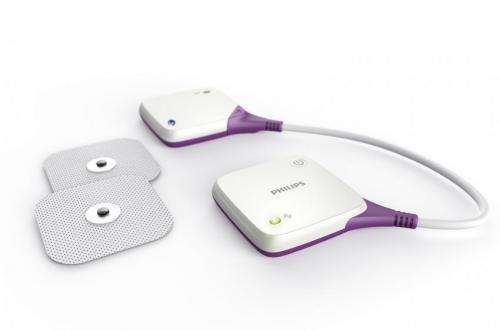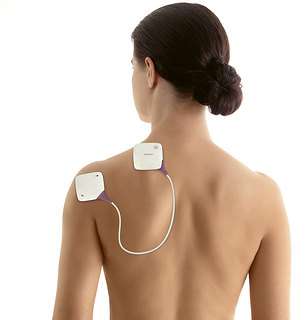September 17, 2014 weblog
Philips introduces BlueTouch, PulseRelief control for pain relief

Pain sufferers have a new way to manage their personal treatment to relieve pain, said Philips. Its introduction this month of BlueTouch and PulseRelief devices involve app-enabled tools managed by iPhones or iPads.
In 2014, we are now at a stage where pain management is clearly a topic involving a broader focus than just on drugs and exploring alternative, drug-free options. Many people suffer from persistent pain that affects their ability to work and to sleep. Friends and families bear the burden too of coping with changed personalities as the result of the person suffering from chronic pain. The BlueTouch is a wireless wearable patch for back pain that uses blue LED light to alleviate the pain. Blue LED light stimulates the production of nitric oxide in the target area, which helps to stimulate blood circulation to the affected area. After a short period of use, 76.8 percent of patients were in the mild pain range compared to just 26 percent before use of the Philips BlueTouch. This is in reference to interim results of a BlueTouch registry. At the end of the study period, 76.8 percent of patients were in the mild pain range (3 cm or less on the VAS scale). The user's smartphone control allows selection from a range of treatments, starting and stopping as needed. The app has a diary so that the user can track treatments.
As for Philips PulseRelief, its purpose is to help relieve mild to moderate chronic musculoskeletal pain. This design offers Transcutaneous Electronic Nerve Stimulation therapy, controlled through a phone app. Electrical pulses are passed across the surface of the skin to activate underlying nerves. The pulses stimulate the body's ability to suppress pain by stopping pain signals to the brain and releasing endorphins. The goal is for the user to achieve better freedom of movement, in relief of mild to moderate chronic musculoskeletal pain. The user gets to select from various programs and intensity levels. A treatment diary on the app is designed for tracking treatment and progress.
Experts generally agree that merely popping a pill to obliterate pain but remaining passive and inactive, in contrast to a previous life style where one worked, studied, and exercised regularly, is not a sound path to recovery.
Elke Naujokat, senior clinical scientist, Philips Pain Relief, commented on the connected products as pain management options. "Staying active despite persistent pain can in turn play an important role in avoiding the vicious cycle of inactivity whereby being afraid of activity leads to its avoidance. This can reduce ability and lead to depression, which then adds to a pain sufferer's fear of activity."

Elsewhere, there are signs of concern that pain management merits a closer look at solutions that can support the quality of life. The AirForceTimes.com reported last month that officials at the Defense and Veterans Center for Integrative Pain Management are seeking to change how doctors approach pain. "In 2010, an Army-led joint task force published a report containing 109 recommendations on pain control, providing a standard training program for military providers, calling for increased patient participation in pain management and offering a menu of options for controlling pain."
Philips, meanwhile, said the "BlueTouch and PulseRelief products will be available from September 2014 and November 2014 respectively in store and online."
More information: www.ifa.philips.com/news/healt … -and-pulserelief-app
© 2014 Tech Xplore

















